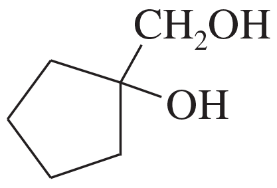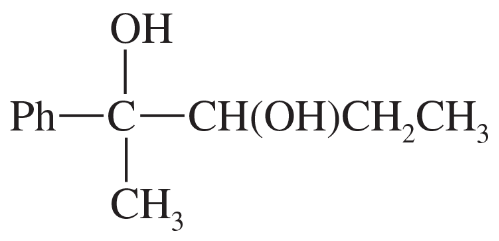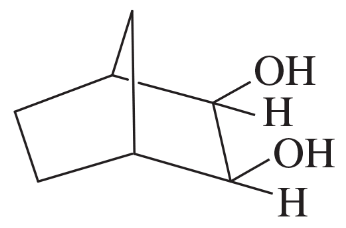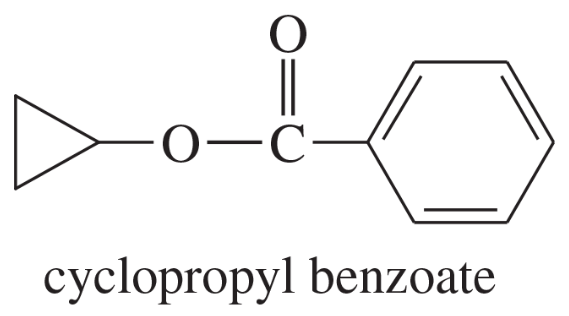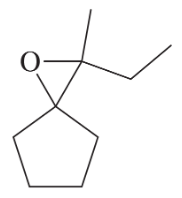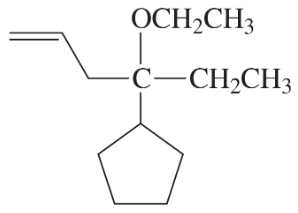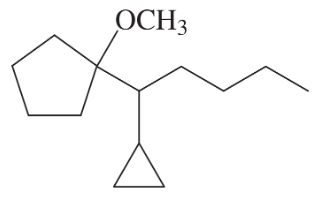 Back
BackProblem 29
The following reaction involves a starting material with a double bond and a hydroxy group, yet its mechanism resembles a pinacol rearrangement. Propose a mechanism, and point out the part of your mechanism that resembles a pinacol rearrangement.
Problem 30a,b
Predict the products formed by periodic acid cleavage of the following diols.
(a) CH3CH(OH)CH(OH)CH3
(b)
Problem 30c,d
Predict the products formed by periodic acid cleavage of the following diols.
(c)
(d)
Problem 31c,d
Show the alcohol and the acid chloride that combine to make the following esters.
(c)
(d)
Problem 32
Use resonance forms of the conjugate bases to explain why methanesulfonic acid (CH3SO3H, pKa = –2.6) is a much stronger acid than acetic acid (CH3COOH, pKa = 4.8).
Problem 33
A good Williamson synthesis of ethyl methyl ether would be
What is wrong with the following proposed synthesis of ethyl methyl ether? First, ethanol is treated with acid to protonate the hydroxy group (making it a good leaving group), and then sodium methoxide is added to displace water.
Problem 34
(a) Show how ethanol and cyclohexanol may be used to synthesize cyclohexyl ethyl ether (tosylation followed by the Williamson ether synthesis).
(b) Why can't we synthesize this product simply by mixing the two alcohols, adding some sulfuric acid, and heating?
Problem 35
A student wanted to use the Williamson ether synthesis to make (R)-2-ethoxybutane. He remembered that the Williamson synthesis involves an SN2 displacement, which takes place with inversion of configuration. He ordered a bottle of (S)-butan-2-ol for his chiral starting material. He also remembered that the SN2 goes best on primary halides and tosylates, so he made ethyl tosylate and sodium (S)-but-2-oxide. After warming these reagents together, he obtained an excellent yield of 2-ethoxybutane.
a. What enantiomer of 2-ethoxybutane did he obtain? Explain how this enantiomer results from the SN2 reaction of ethyl tosylate with sodium (S)-but-2-oxide.
b. What would have been the best synthesis of (R)-2-ethoxybutane?
c. How can this student convert the rest of his bottle of (S)-butan-2-ol to (R)-2-ethoxybutane?
Problem 36
Phenols (pKa ≈ 10) are more acidic than other alcohols, so they are easily deprotonated by sodium hydroxide or potassium hydroxide. The anions of phenols (phenoxide ions) can be used in the Williamson ether synthesis, especially with very reactive alkylating reagents such as dimethyl sulfate. Using phenol, dimethyl sulfate, and other necessary reagents, show how you would synthesize methyl phenyl ether.
Problem 37a
To practice working through the early parts of a multistep synthesis, devise syntheses of
(a) pentan-3-one from alcohols containing no more than three carbon atoms.
Problem 37b
To practice working through the early parts of a multistep synthesis, devise syntheses of
(b) 3-ethylpentan-2-one from compounds containing no more than three carbon atoms.
Problem 38a
Develop syntheses for the following compounds. As starting materials, you may use cyclopentanol, alcohols containing no more than four carbon atoms, and any common reagents and solvents.
(a) trans-cyclopentane-1,2-diol
Problem 38b
Develop syntheses for the following compounds. As starting materials, you may use cyclopentanol, alcohols containing no more than four carbon atoms, and any common reagents and solvents.
(b) 1-chloro-1-ethylcyclopentane
Problem 38c
Develop syntheses for the following compounds. As starting materials, you may use cyclopentanol, alcohols containing no more than four carbon atoms, and any common reagents and solvents.
(c)
Problem 38d
Develop syntheses for the following compounds. As starting materials, you may use cyclopentanol, alcohols containing no more than four carbon atoms, and any common reagents and solvents.
(d)
Problem 38e
Develop syntheses for the following compounds. As starting materials, you may use cyclopentanol, alcohols containing no more than four carbon atoms, and any common reagents and solvents.
(e)
Problem 38f
Develop syntheses for the following compounds. As starting materials, you may use cyclopentanol, alcohols containing no more than four carbon atoms, and any common reagents and solvents.
(f)
Problem 39a,b
Predict the major products of the following reactions, including stereochemistry where appropriate.
(a) (R)-butan-2-ol + TsCl in pyridine
(b) (S)-2-butyl tosylate + NaBr
Problem 39c,d
Predict the major products of the following reactions, including stereochemistry where appropriate.
(c) cyclooctanol + NaOCl/HOAC
(d) cyclopentylmethanol + CrO3·pyridine·HCl
Problem 39e,f,g
Predict the major products of the following reactions, including stereochemistry where appropriate.
(e) cyclopentylmethanol + Na2Cr2O7/H2SO4
(f) cyclopentanol + HCl/ZnCl2
(g) n-butanol + HBr
Problem 39h,i,j
Predict the major products of the following reactions, including stereochemistry where appropriate.
(h) cyclooctylmethanol + CH3CH2MgBr
(i) potassium tert-butoxide + methyl iodide
(j) sodium methoxide + tert-butyl iodide
Problem 39k,l,m
Predict the major products of the following reactions, including stereochemistry where appropriate.
(k) cyclopentanol + H2SO4/heat
(l) product from (k) + OsO4/H2O2, then HIO4
(m) sodium ethoxide + 1-bromobutane
Problem 39n,o,p
Predict the major products of the following reactions, including stereochemistry where appropriate.
(n) sodium ethoxide + 2-methyl-2-bromobutane
(o) octan-1-ol + DMSO + oxalyl chloride
(p) 4-cyclopentylhexan-1-ol + DMP reagent
Problem 40a,b,c
Show how you would convert 2-methylcyclopentanol to the following products. Any of these products may be used as the reactant in any subsequent part of this problem.
a. 1-methylcyclopentene
b. 2-methylcyclopentyl tosylate
c. 2-methylcyclopentanone
Problem 40d
Show how you would convert 2-methylcyclopentanol to the following products. Any of these products may be used as the reactant in any subsequent part of this problem.
d. 1-methylcyclopentanol
Problem 40g,h
Show how you would convert 2-methylcyclopentanol to the following products. Any of these products may be used as the reactant in any subsequent part of this problem.
(g) 2-methylcyclopentyl acetate
(h) 1-bromo-1-methylcyclopentane
Problem 41a,b
In each case, show how you would synthesize the chloride, bromide, and iodide from the corresponding alcohol.
(a) 1-halobutane (halo = chloro, bromo, iodo)
(b) halocyclopentane
Problem 42a,b
Show how you would accomplish the following synthetic conversions.
(a)
(b)
Problem 42c
Show how you would accomplish the following synthetic conversions.
(c)
Problem 42d
Show how you would accomplish the following synthetic conversions.
(d)


